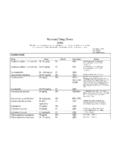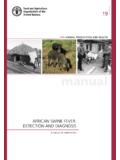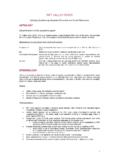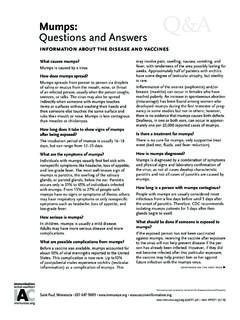Transcription of Potomac Horse Fever Neorickettsia risticii - NICUvet
1 Potomac Horse FeverNeorickettsiaristiciiSynonyms Potomac Horse Fever (PHF) Equine Monocytic Ehrlichiosis (EME) Equine Ehrlichial Colitis (EEC) Equine Ehrlichial Abortion (EEA) Potomac Horse feverEpidemiology Subclinical infection-16-33%Healthy horsesNo history of illness Transient, low antibody titersRepeated exposure tosubinfectivedosesCross reaction with other microbesPotomac Horse feverSeasonal Fluctuation Highest number Clinically affected horsesJulyAugustSeptember 70% of 900 clinical cases in Maryland (5 yrs) Potomac Horse feverClinical Disease Sporadic Enzootic areaFrequent occurrence in areaLow attack rate (<5%) on farms Epizootic areaHigh attach rate (20-50%) on farmsPotomac Horse feverMontgomery County, MDYearCasesFarms198211251198311675198410 168 Potomac Horse feverTransmission Direct Insect vector OralPotomac Horse feverVector Vectors of other ehrlichial agents are ticks Only adult tick found parasitizing horsesalong the Potomac river:DermacentorvariabilisPotomac Horse feverDermacentorvariabilisLarval and nymph stages feed on small ground mammalsAttempts to transmitE.
2 Risticiito normal horses usingfield captured adult ticks ( ) failedLarval and nymph stages fed on ehrlichemic mice will nottransmit to other mice or to poniesMice from endemic areas consistentlyseronegativeDogs uniformlyseronegativeon endemic farmsPotomac Horse feverVector Dermacentorvariabilisis not the vector Attempts to transmit have also failed with:RhipicephalussanguineusIxodesscapul arisAmblyommaamericanumPotomac Horse feverNatural Infection Horse Dog Cat Goat Pig Rabbit FoxPotomac Horse feverTransmission Studies Cat fleaCtenocephalidesfelis Chigger miteNeotrombiculawhartoni Hematophagous fliesAdult stable flies (Stomoxyscalcitrans) Potomac Horse feverOral Infection Ehrlichia shed into colon Direct contact will not result in transmission Concentration of the Ehrlichia in a vectorNeorickettsiahelminthoecaN. elokominicaPotomac Horse feverOral Transmission Survival outside host ConcentrationInsectsNematodesCercariae(f luke larvae),Operculatesnails (Pleuroceridae:Juga),Caddisflies (Dicosmoecusgilvipes)
3 CaddisfliesPotomac Horse feverClinical Manifestations Fever Depression Anorexia Ileus Colic Diarrhea LaminitisPotomac Horse feverBiphasic Fever Initial Fever 103-106 FNo other signs Second Fever in 3-7 daysPersistent feverAssociated depression, anorexiaPotomac Horse feverManifestations of Colitis Not always colic or diarrhea Depression and anorexia With or without Fever Normal feces Remarkable decreased borborygmiPotomac Horse feverDiarrhea Diarrhea less than 60% of cases Cow-like feces to watery, pipe-stream Not as profuse as salmonellosis Course 1-10 daysPotomac Horse feverClinical Disease Course without therapeutic intervention5 to 10 days Fatality rate untreated clinical cases5 to 30% Potomac Horse feverHematologic Findings Early phase-variableLeukopenic similar to salmonellosisNormalhemogramsdespite endotoxic enteritis Later phaseMarked leukocytosis 20,000 to 30,000 DiagnosisSerology Rapid rise in antibody titerbefore the onset of clinical signs Levels peak within a few daysDiagnosis IFA Titers Usually positive at onset 4 fold increase or decrease-diagnostic No change frequently found Titers persist for > 1 yr Single titer not diagnostic High rate of false positives-unreliableComparison of N.
4 risticii SerologySerumLab #1 Lab #2 Lab #3 Lab#4 WesternBlotUnknown #11:801:3201:160 NegNegUnknown #21:6401:6401:320 NegNegUnknown #31:3201:401:160 NegNegUnknown #41:3201:1601:160 NegNegUnknown #51:3201:401:20 NegNegNegativeNegNegNegNegNegPositive1:3 201:3201:12401:20 PositiveDetection of N. risticii byPolymerase Chain Reaction (PCR) Sensitive Rapid Blood, tissues, feces LimitationsExtreme sensitivity-false positivesTarget build up contaminationCross contaminationInterfering substancesDrug of Choice for TreatingN. risticii Infection Oxytetracycline mg/kg SID Response to treatment within 12 hoursDrop in rectal temperatureImproved attitude, appetite, borborygmal sounds Response-clinical diagnosis Treatment with oxytetracycline associatedwith acute enteritisPrevention Daily tick removal Systematic application of insecticides Yellow lights around Horse areasVaccines Inactivated, partially purified, whole cellPHF-VAX ,Potomavac , Potomac Guard Protection partial at bestFevers 81%, Depression 23%, Diarrhea 23% Multiple strains poor cross protectionCan have severe disease and fatalities during outbreaksVaccination Protection appears to wane within months33% protection 9 months post vaccination50% protection 6 months post vaccination Revaccination at 4 month intervals2 times a yearEquine Ehrlichial Abortion Infection-100 to 160 days of gestationMares developed typical signs of EECA bort-190 to 250 days of gestation Placentitis, retained placenta Fetal colitis.
5 Periportal hepatitis and lymphoid hyperplasiaFoals carried to term Healthy Not FeverINTRODUCTIONP otomac Horse Fever is an acute enterocolitis of equines caused by a group of closelyrelated intracellular-occurring ehrlichias collectively known asNeorickettsiaristicii, firstrecognized in 1979 along the Potomac River in Maryland, USA.[29]Neorickettsiaristiciiinfection in horses has been referred to as Potomac Horse Fever , equine monocyticehrlichiosis, and equine ehrlichial colitis. It has been recognized to occur throughoutNorth America. The original term, " Potomac Horse Fever ", was coined by a televisionreporter covering the original epidemic along the Potomac River. Although it is the leastdescriptive term, its wide acceptance and its high level of recognition ensures that it willremain the most common term for the disease. Equine ehrlichial colitis is a moredescriptive term for the original syndrome of Fever , anorexia, depression and mild cases not manifesting diarrhea have evidence of colitis.
6 Equine ehrlichialabortion is an appropriateterm for the abortion syndrome caused byN. causative organism of Potomac Horse Fever is a member of the tribe Ehrlichieae.[23]Based on nucleotide sequence, the genusEhrlichiais phylogenetically most closely related toNeorickettsiasennetsuandNeorickettsiah elminthoeca(levels of sequence similarity, > 95%).[55] Although only definitivelyproven forN. helminthoeca, it is likely that these three organisms also share the uniqueproperty of being the only known obligate intracellular bacteria that are transmitted via ahelminth risticiigrows readily in a number of tissue culture lines as long asantimicrobials are not used in the culture media, the continuous murine macrophage cellline P388D1 is frequently used for isolation and propagation. The original Marylandisolate grows readily in this cell line initially appearing as a cluster of singly occurringelementary bodies followed by the development of initial bodies andlater formingmorulae (mature inclusions).
7 Heavily infected cells eventually disintegrate, releasingloosely packed groups of organisms held together by cytoplasmic stroma. [69]There is considerable biological diversity ofN. risticiiisolates from clinical cases ofPotomac Horse Fever . Morphologically, some form large cytoplasmic morulae (inclusions)whereas others form small morulae or are individually dispersed in the cytoplasm inmurine P388D1cells.[11] Similarly, patterns of antigenic proteins maydifferconsiderably between isolates.[11] The sequences of the 16S rRNA genes of isolates maydiffer between each other more than from the next most closely relatedNeorickettsiasp.,Neorickettsiasen netsu. It is evident that Potomac Horse Fever is not caused by ,VMDNEWBOLTONCENTER2 Neorickettsiabut rather several closely related but distinctNeorickettsiaspp.[83] Thisantigenic variation of isolates causing the same clinical disease has resulted in incompleteprotection from the first generation of vaccines which all originated from the same typestrain ofN.
8 Horse Fever is confined to North America where it has been reported in a widevariety of geographic regions in most US states and Canada. Surveys in the USA haveshown that 16 to 33%of horses with no history of illness have antibodies toN. risticii [18,39, 65] and that these are seasonal fluctuations with the highest number of seropositivehorses and highest clinical occurrence in July, August and September.[18, 39] Over a fiveyear period 70%of 900 clinical cases recorded in Maryland occurred during the samemonths.[53]Clinical disease shows an unusual sporadic pattern with a low prevalence rate (<5%) onany one farm despite its frequent occurrence in an endemic area. In fact,when multiplecases occur on a large farm, the pattern is also temporally (within the season of thedisease) and geographically (among the pastures and barns on the farm) an epidemic form occurs which is characterized by a high attack rate (20 to50%) on an individual farm. The disease may be concentrated on a particular farm or racetrack, resulting in an outbreak of a large number of horses simultaneously.
9 The reason forthis epidemiological variation is unknown.[45, 48]The modeof transmission has been extensively studied but significant questions continueto exist. Direct contact transmission does not occur.[44] The seasonal occurrence lead toearly investigation of a possible arthropod vector. Common vectors of other ehrlichialagents are ticks.[67] The only adult tick found feeding on horses along the Potomac Riverduring the original epidemic in the early 1980s wasDermacentor variabilis.[9, 72] Thelarval and nymphal stages of this tick feed on small ground mammals such as the white-footed mouse (Peromyscus leucopus).[9] Mice are highly susceptible to [24] However, attempts to transmitN. risticiito horses using fieldcaptured adult ticks (Dermacentor variabilis) from endemic farms failed.[72]Furthermore, larval and nymphal stages ofDermacentor variabilisfed on ehrlichaemicmice did not transmit the organism to other mice or to ponies[20, 30] and white-footedmice infested with immatureDermacentor variabilisand living in endemic areas ofthedisease have consistently been found to be seronegative.
10 [9] Dogs, the primary host ofadultDermacentor variabilis, are uniformly seronegative on endemic farms[53] despitebeing susceptible to infection.[68]Dermacentor variabilisis not the vector ofN. risticiiand attempts to transmit the pathogen with other ticks includingRhipicephalussanguineus,Ixodes scapularis,andAmblyomma americanumhave also failed.[20]Despite the wide experimental host susceptibility ofN. risticii ,[13, 24, 68, 77] non-equinemammals in endemic areas show a surprisingly low frequency of seroconversion.[9, 19, ,VMDNEWBOLTONCENTER353, 71] One investigation revealed that a high percentage of cats on some endemic farmswere seropositive,[53] but transmission studies using the cat fleaCtenocephalides felisand the chigger miteNeotrombicula whartoni, both common ectoparasites of cats onendemic farms, failed whenN. risticiiinfected horses or mice were used as donors andmice were used as recipients.[71]The ehrlichaemia that occurs during the acute stage of the disease makes transmission byhaematophagous flies possible.






